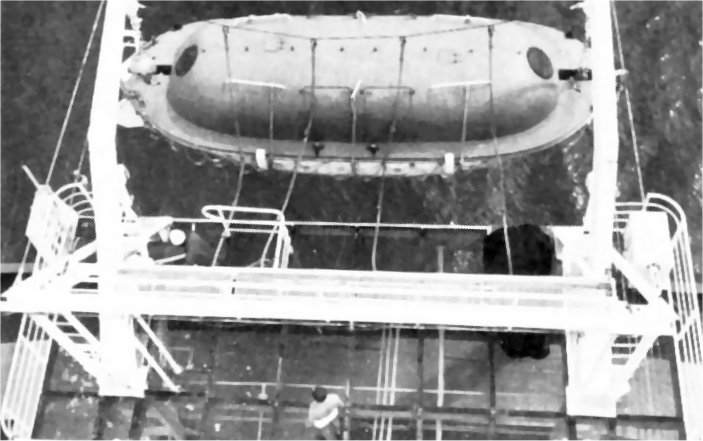Auke Visser´s ESSO Tankvaart Mij. Site | home
The call of the sea that is full of promises - Part-2
Source : Esso Singapore News, November, 1978.
Or a tanker ride down the Malacca Straits - Part-2
By Lam Yeen Fong
Another element of interest about the Bonaire crew is Second Officer Marja Idzinga.
The only female staff member on board and the first woman to sail with Esso Nederlands, (she remains the only lady sailor as other women who have joined after her have since left to raise a family) Marja also happens to be married to the Bonaire’s sole electrician.
 Second Officer Marja Idzinga who is one of a kind on board the Bonaire, checks the fire-fighting apparatus daily.
Marja started sailing as an apprentice when she was 17, and now at 24, is as proficient as any of her male counterparts.
As Second Officer, she is responsible for maintaining all nautical equipment, including logbooks, tidetables, charts, maps and the tanker’s fire safety program. A day‘s work would involve keeping watch on the bridge and checking or repairing the various fire-fighting equipment located throughout the vessel — including the coordination of weekly fire drills on different aspects of the tanker’s operations.
Both Marja and her husband Nicolaas Tiemens — who sees to all the electrical requirements of the tanker — are committed to not
having children for the love of the sea.
“No pregnant woman is allowed to sail, though wives of our staff are allowed to accompany their husbands on board. I’d always wanted to try sailing, and l’ve found that I like it," she said. “I intend to go on for as long as loan.”
So would most of the Bonaire crew echo her sentiments.
 Chief Officer Willem Visser mans the cargo control room which enables computerized loading and unloading of cargo.
Chief Officer Willem Visser — who heads the nautical department — and Chief Engineer Jacobus Pronk, head of the technical department, are both veterans at sea, having completed some 41 years of seagoing experience between them.
Chief Officer Visser looks after the cargo loading, the housekeeping and deck maintenance crew, besides helping out on the bridge.
When asked what is the most difficult aspect of work at sea, Visser’s answer was: “The sea itself.”
“The sea is our worst enemy," he continued. “We’re constantly battling against rust. Every opportunity must be seized to paint and repaint the Ship else time will simply get a head of us."
This is where the deckhands and fitters make their contribution. Everyday, some part of the deck would need to be repaired or painted. The tip-top condition of the Bonaire deck testified to an excellent job done.
A professional at heart, Visser laments the administrative rigmarole that even the sea is not immune from, “There is too much paper work so many documents to wade through. We never have to do so much typing and Xeroxing before. Now we have a zerox machine onboard and everybody gets a copy of all kinds of notices.”
Chief Engineer Pronk supervises a team of assistant engineers in manning a constant Watch over the steam production necessary to drive the ship.
“Our engines operate exactly like those in a steamship except that they are computer controlled,” said Pronk, at 48 the oldest member on board, and a lover of all things associated with the sea.
 The kitchen Staff. Steward Monteiro; Baker Dos Santos and Steward Lima.
The nerve centre of the steam production process is the Control Room. It regulates the quantity of sea water that is pumped in to
be distilled before it is boiled to provide steam. Some 250,000 lbs. of steam is required to drive the tanker at a maximum speed of 16 knots per hour.
Working in the engineroom means having to sustain high temperatures which can be as much as 130°F a times. Though as Pronk admitted, “The air-conditioned Control Room has helped to make our work easier and more efficient.”
Fourth Engineer Ruud Nadels agreed. All other things being equal, he prefers life on board the Bonaire than holding a job on land.
“Each of us have our specific duties, and we can work at our own pace — so long as the job is done, and done well,” he said.
Off-duty hours are spent.
 Relaxing at the bar. The crew is playing a self-devised game called “GANZEBORD".
Left to right; ?, BF (Bram) Stoel, Willem van Laren ??, and Ruud Nadels.
reading or studying for higher qualifications, playing “GANZEBORD” (literally goosegame) which the crew made up themselves, watching videotapes, listening to music, guzzling the Dutch national drink — Heineken beer, taking a dip in the swimming pool or exercising in the recreation room.
A radio office which receives the daily news from Holland also allows for long distance calls and entries to be submitted to Dutch football pools.
“I like my life here," Ruud added. “When I work, I really work. And when I go on leave, I am on vacation for the longest period possible in any job.” This amounts to some three to five months in a year, depending on seniority.
 An able-bodied Seaman Fortes, on the Iookout for approaching vessels in the busy Malacca Straits.
And as Captain Kuijpers pointed out earlier, the intense quality of a sailor’s life — whether at work or on home leave — more than makes up for whatever privileges he has to forgo.
The housekeeping and deck maintenance crew — most of whom are of Portuguese origin from Cape Verde off West Africa — shared the same view.
As Galley boy Suarez puts it: “It is hard to get a job on the land. We are Well treated here and we work well together."
Likewise, for able-bodied seaman Antonio, “the work is fine once you get used to it. And I’ve always liked the sea though I’ve never
seriously thought about why I do so.“
 The crane that lowers the lifeboal is regularly checked to ensure that it is funcrioning properIy.
|